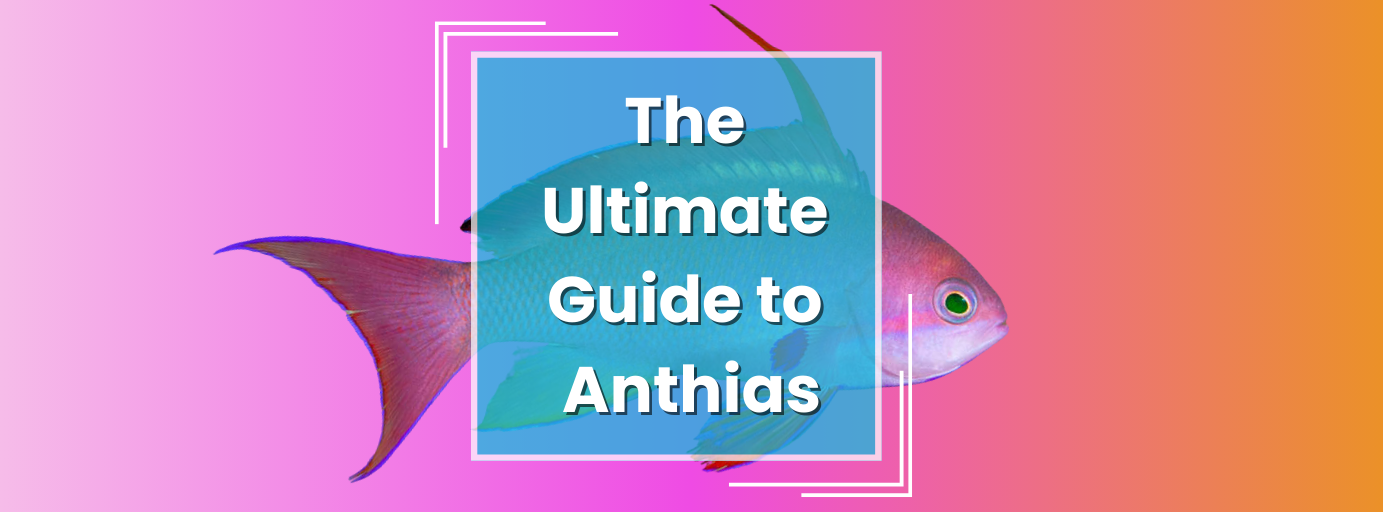
𝐀𝐧𝐭𝐡𝐢𝐚𝐬 𝐂𝐚𝐫𝐞:
𝐓𝐡𝐞 𝐔𝐥𝐭𝐢𝐦𝐚𝐭𝐞 𝐆𝐮𝐢𝐝𝐞
Introduction
Anthias are like the tropical birds of the reef world—bursting with color, endlessly active, and undeniably captivating. But keeping these beauties thriving in a saltwater aquarium requires more than admiration. They’re stunning, yes, but they’re also delicate, finicky, and just a little bit diva-esque. Whether you’re a new hobbyist eyeing your first shoal or a seasoned aquarist looking for a challenge, this guide will walk you through everything you need to know about anthias care.
What Makes Anthias Unique?
Anthias hold a special place in the hearts of saltwater aquarists, and for good reason. Their dazzling colors, dynamic behavior, and natural schooling tendencies bring life and movement to reef tanks in a way few other fish can match. Here’s what makes them so beloved:
1. Vibrant Colors That Pop
- Anthias are like living jewels, coming in an array of colors that rival the brightest corals. From the fiery reds and oranges of Lyretail anthias to the soft pinks and purples of Bartlett’s anthias, their hues add depth and vibrancy to any tank.
- Many anthias also exhibit sexual dimorphism, with males displaying even more intense colors, making a harem of anthias visually striking.
2. Natural Schooling Behavior
- Anthias are schooling fish by nature, often seen swimming in tight, synchronized groups in the wild. This behavior translates beautifully into aquariums, where they create an active, mesmerizing display as they dart through the water column.
- Their schooling also adds a sense of natural realism to reef tanks, mimicking how fish behave on wild coral reefs.
Tamara’s Pro Tip: To truly enjoy their schooling behavior, house them in harems with one male and 4–6 females. This dynamic not only keeps aggression in check but also mirrors their natural social structure.
3. Constant Activity
- Unlike some reef fish that spend their days hiding or hovering, anthias are always on the move. They inhabit the midwater column, swimming gracefully and exploring their environment, making your tank feel alive and dynamic.
4. Reef Compatibility
- Anthias are generally reef-safe, meaning they won’t nip at corals or invertebrates, making them an ideal choice for mixed reef setups.
- They coexist well with other peaceful tankmates, such as tangs, wrasses, and gobies, making them versatile additions to community tanks.
Tamara’s Pro Tip: While anthias are peaceful, avoid housing them with overly aggressive species like large angelfish or predatory triggers—they’ll feel intimidated and may stop schooling or eating.
5. Fascinating Hierarchies
- Anthias have complex social structures, with one dominant male maintaining order in the harem. Watching the interactions between the male and females provides a glimpse into their natural behavior and adds an extra layer of interest to your tank.
- Fun Fact: If the male in the group dies, the dominant female can change sex and take his place—a fascinating and rare adaptation in the fish world.
6. Variety for Every Hobbyist
- With over 10-15 species in the anthias family usually found in the aquarium trade. Whether you’re a beginner looking for hardy Lyretail anthias or an experienced reefer up for the challenge of a delicate Sunburst anthias, there’s a species that fits your skill level and tank setup.
7. A Challenge Worth Mastering
- Anthias present a manageable but rewarding challenge. Their need for frequent feedings, pristine water quality, and specific social structures make them ideal for aquarists who want to hone their skills and level up their reefing game.
Tamara’s Pro Tip: Invest in an automatic feeder to keep up with their high metabolism. Anthias thrive on multiple small meals throughout the day, mimicking their natural feeding habits on the reef.
8. Tank Showstoppers
- Anthias tend to stand out in any tank setup, drawing the eye with their brilliant colors and constant activity. They’re a perfect choice for aquarists who want a centerpiece species that doesn’t overshadow the rest of the tank but enhances its beauty.
Top 12 Most Common Anthias Species
Anthias are among the most stunning and dynamic fish in the saltwater hobby, but their care varies significantly across species. Here’s an in-depth guide to the top 8 most commonly kept anthias, their care requirements, and their suitability for beginners or advanced aquarists.
Factors Influencing Availability:
- Region: The availability of certain species can depend on collection locations (e.g., Red Sea, Indo-Pacific, etc.).
- Aquarist Demand: Hardy and colorful species like Lyretails and Bartlett’s dominate the trade due to their adaptability and appeal.
- Sustainability: Some rarer species, such as deepwater anthias, are less commonly seen due to the difficulty of collection and concerns about sustainability.
1. Lyretail Anthias (Pseudanthias squamipinnis)
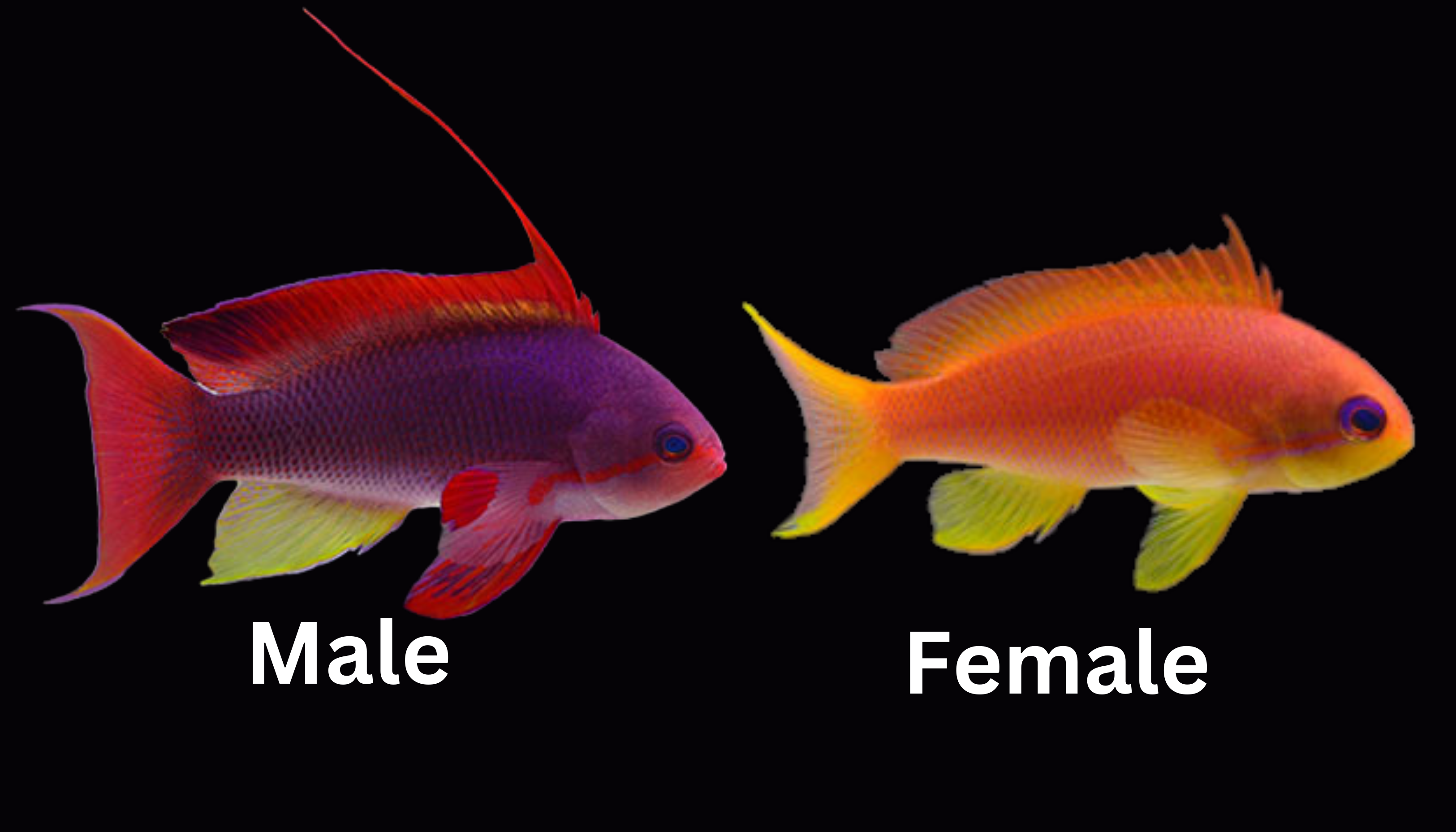
- Skill Level: Beginner
- Care Needs:
- Tank Size: Minimum 75 gallons for a small group; larger tanks (100+ gallons) preferred.
- Diet: Carnivorous; feed small, frequent meals (2–3 times daily) of frozen mysis, brine shrimp, and high-quality pellets or flakes.
- Behavior: Peaceful and hardy; forms a natural hierarchy with one dominant male.
- Concerns: Ensure enough females (4–6 per male) to distribute aggression and maintain social harmony.
Tamara's Pro Tip: Lyretails are one of the most forgiving anthias species, making them perfect for aquarists starting with anthias.
2. Bartlett’s Anthias (Nemanthias bartlettorum)
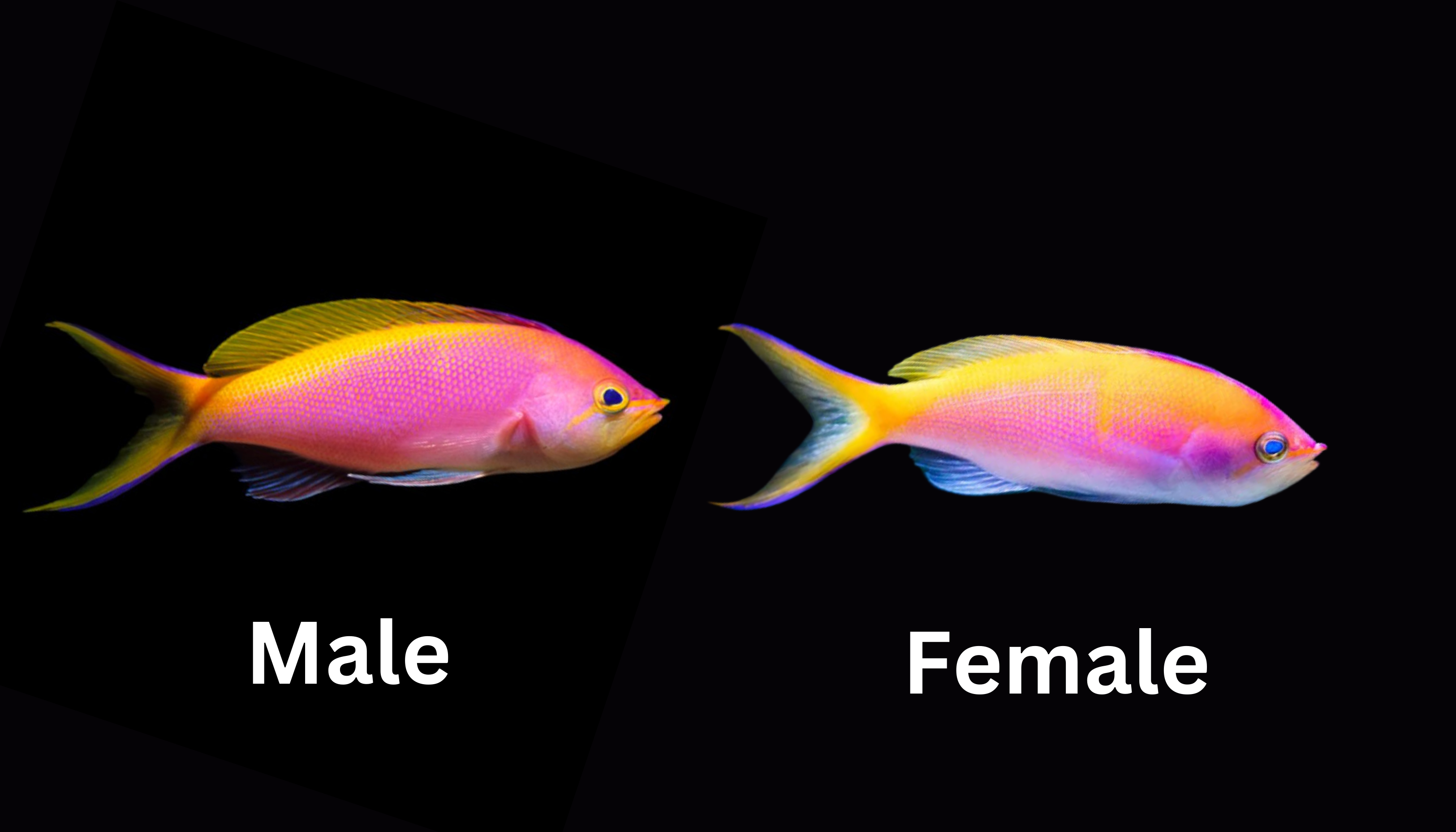
- Skill Level: Beginner to Intermediate
- Care Needs:
- Tank Size: 70–100 gallons for a small group.
- Diet: Easy to feed; accepts frozen and prepared foods, but benefits from enriched options like mysis shrimp.
- Behavior: Bold and active, often schooling in the water column.
- Concerns: Can become aggressive within their group; maintain a 1:4 male-to-female ratio.
Tamara's Pro Tip: Bartlett’s anthias adapt well to captive environments but thrive best with consistent water parameters and high oxygenation.
3. Dispar Anthias (Nemanthias dispar)
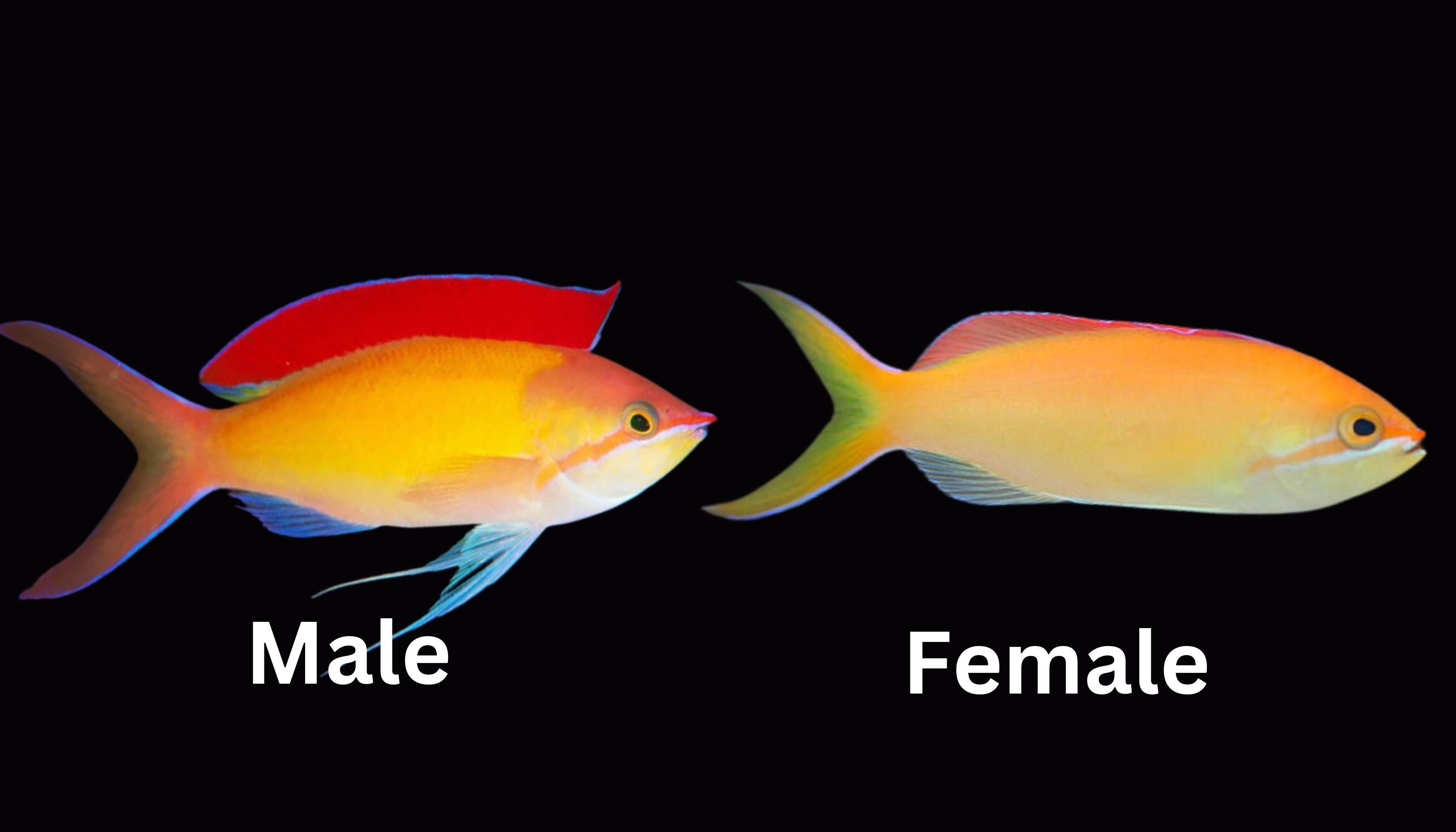
- Skill Level: Beginner to Intermediate
- Care Needs:
- Tank Size: 75 gallons for a small group; needs open swimming areas and some rockwork for retreating.
- Diet: Omnivorous but prefers frozen foods and small live prey like copepods or enriched brine shrimp.
- Behavior: Peaceful and easy-going; less prone to intra-group aggression.
- Concerns: Nutritional deficiencies can lead to dull coloration—ensure a varied diet.
- Tamara's Pro Tip: Dispar anthias are excellent for peaceful community tanks and are less aggressive than many other species.
4. Sunburst Anthias (Serranocirrhitus latus)
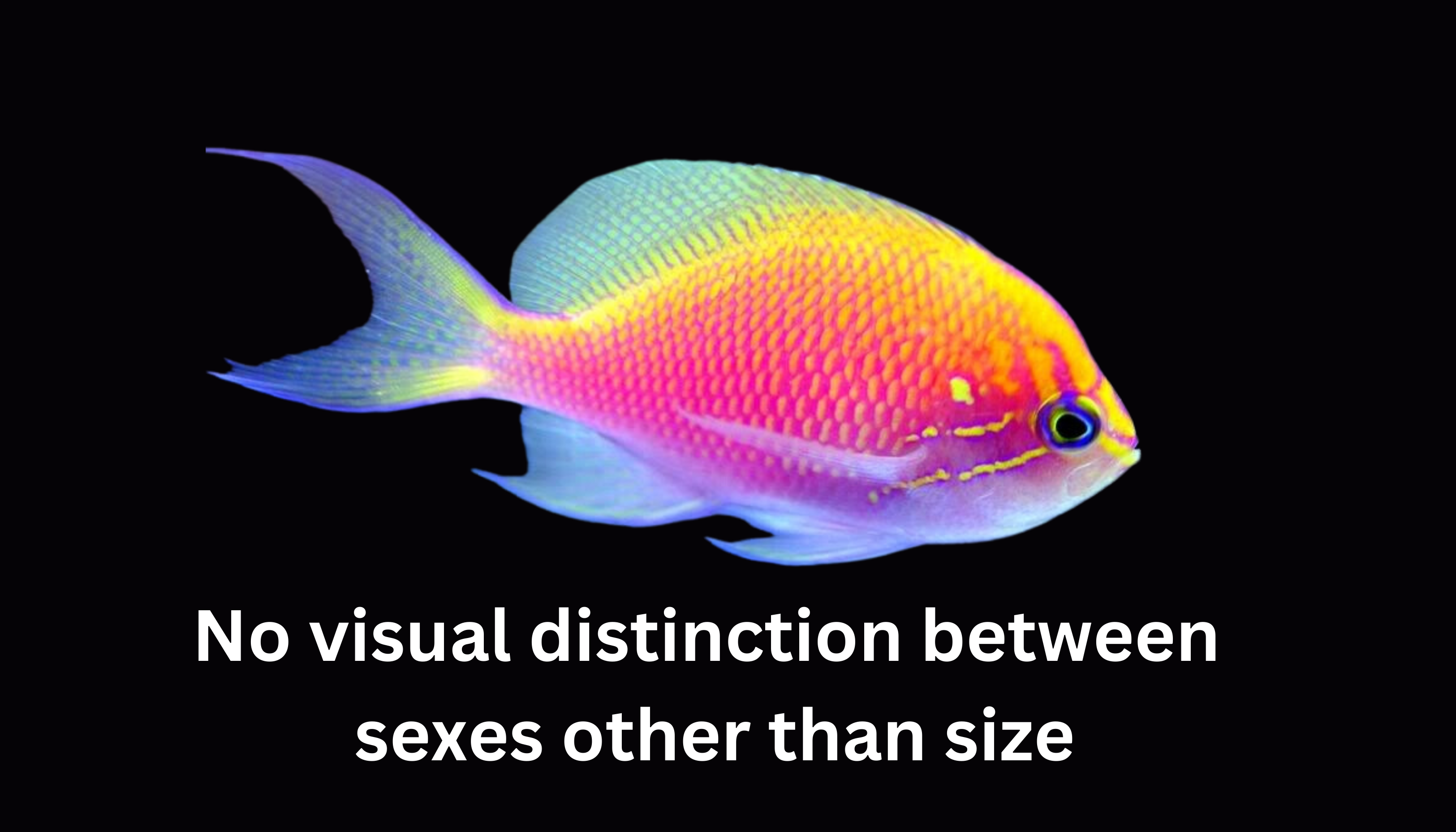
- Skill Level: Advanced
- Care Needs:
- Tank Size: 50 gallons or more; prefers lower lighting and subdued environments.
- Diet: Shy eater; requires a mix of frozen plankton, cyclopeeze, and live foods to entice feeding.
- Behavior: Solitary or in very small groups; not a strong schooling species.
- Concerns: Easily outcompeted for food, so avoid housing with aggressive feeders.
Tamara's Pro Tip: Provide a quiet tank setup with caves or overhangs for Sunburst anthias to feel secure.
5. Pink Square Anthias (Pseudanthias pleurotaenia)
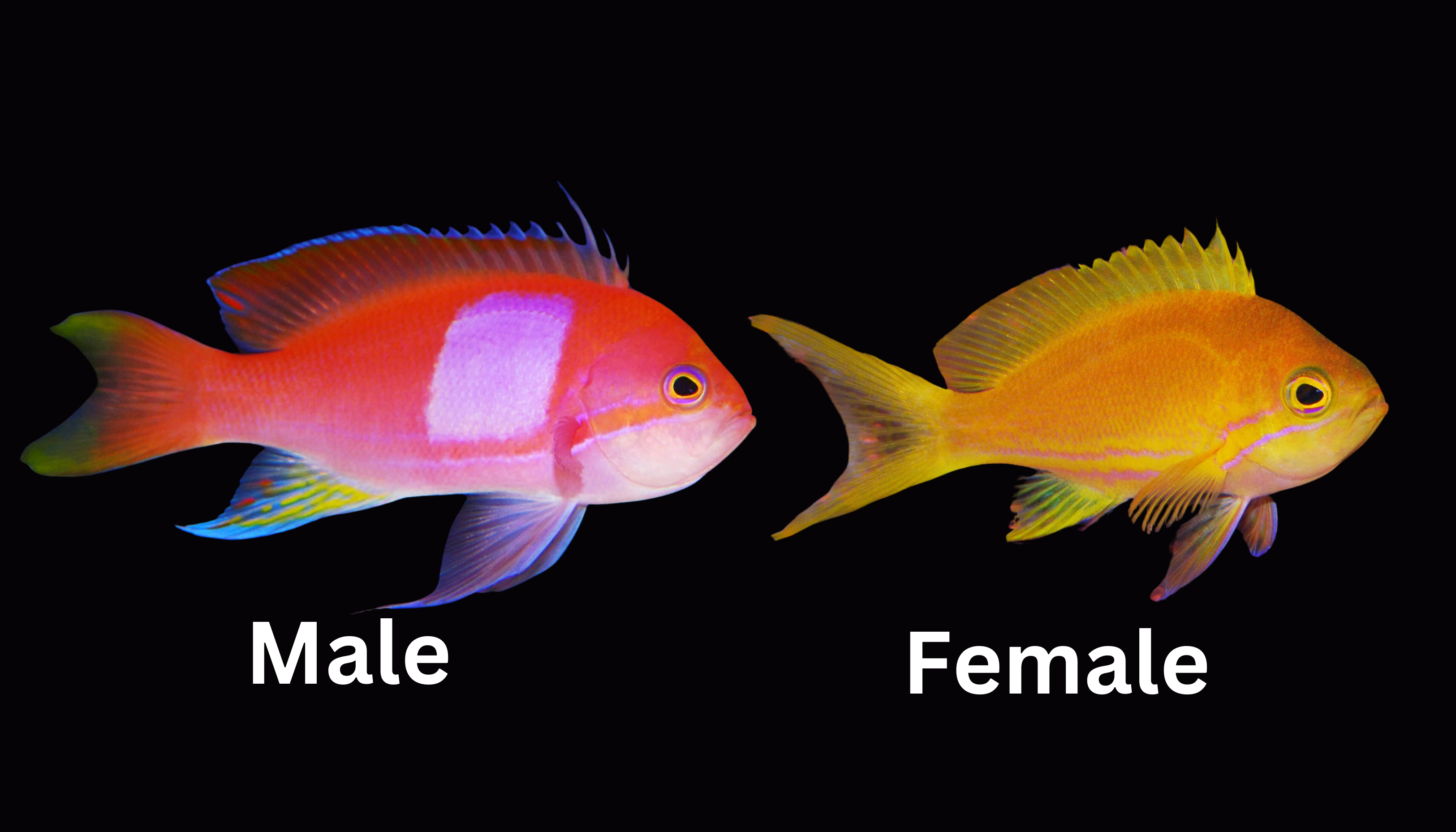
- Skill Level: Intermediate to Advanced
- Care Needs:
- Tank Size: Minimum 125 gallons; requires significant swimming space and structured rockwork.
- Diet: Carnivorous; thrives on small, frequent feedings of meaty foods.
- Behavior: Larger and more territorial than other anthias; males can be aggressive.
- Concerns: Male dominance can lead to stress in smaller tanks; keep a harem with at least 4–6 females per male.
Tamara's Pro Tip: Squarebacks are visually striking but need space and careful group management to prevent aggression.
6. Bicolor Anthias (Nemanthias bicolor)

- Skill Level: Advanced
- Care Needs:
- Tank Size: 100 gallons minimum; excels in tanks with vertical structures for retreating.
- Diet: Picky eater; requires a steady supply of live or frozen planktonic foods.
- Behavior: Active swimmer but shy; acclimates slowly to captive conditions.
- Concerns: Susceptible to stress-related diseases like Velvet or Ich if water quality fluctuates.
Tamara's Pro Tip: Ideal for aquarists with experience acclimating delicate fish. Stable water conditions are non-negotiable.
7. Threadfin Anthias (Nemanthias carberryi)
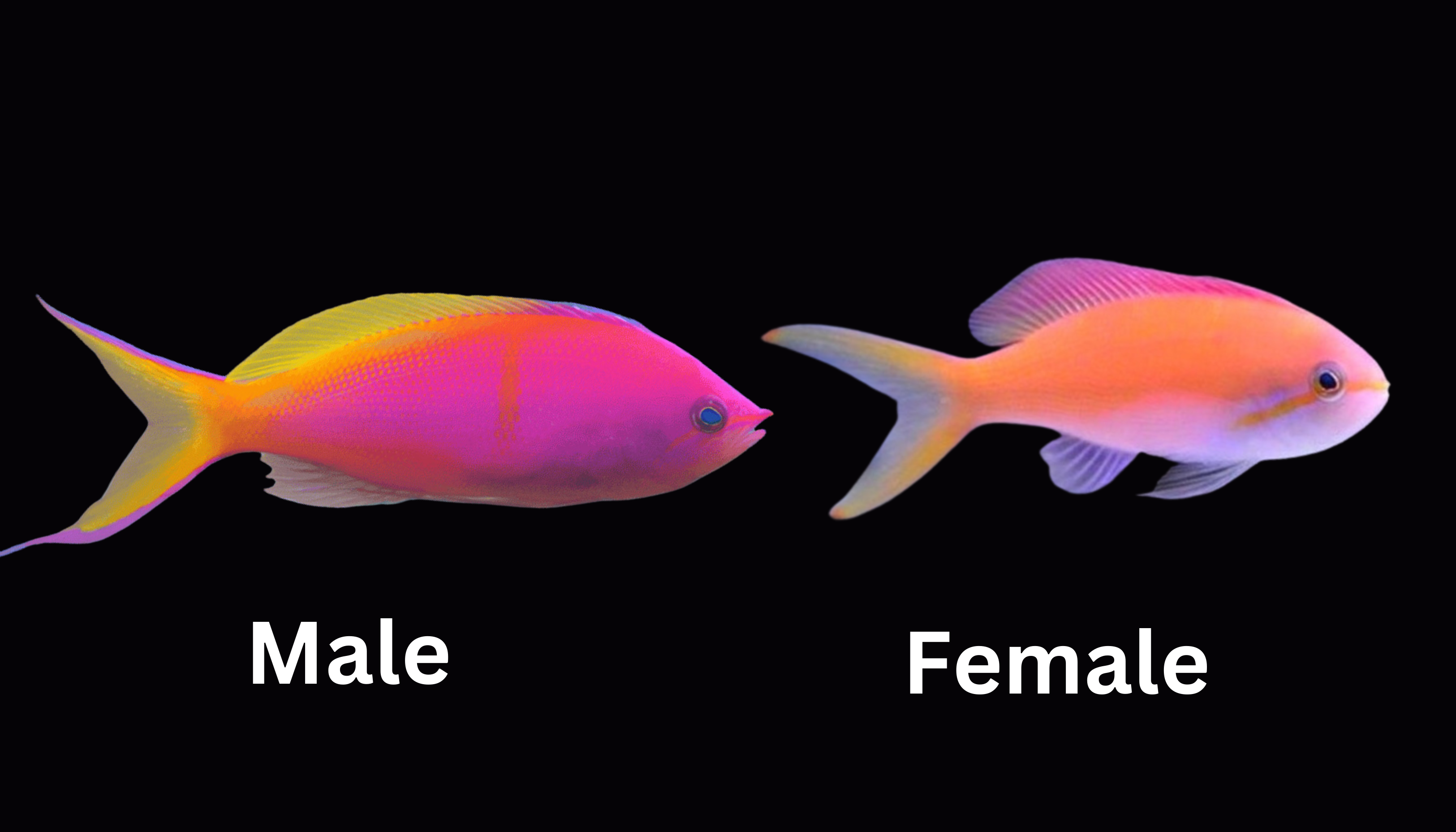
- Skill Level: Intermediate
- Care Needs:
- Tank Size: 75 gallons for a group of 5–6.
- Diet: Omnivorous; responds well to frozen mysis, cyclopeeze, and fine pellets.
- Behavior: Peaceful and tightly schooling; works well in community tanks.
- Concerns: Requires excellent flow to mimic reef currents and oxygenate the tank.
Tamara's Pro Tip: Threadfins are stunning additions to tanks with strong current setups but need frequent feedings to maintain energy.
8. Resplendent Anthias (Pseudanthias pulcherrimus)
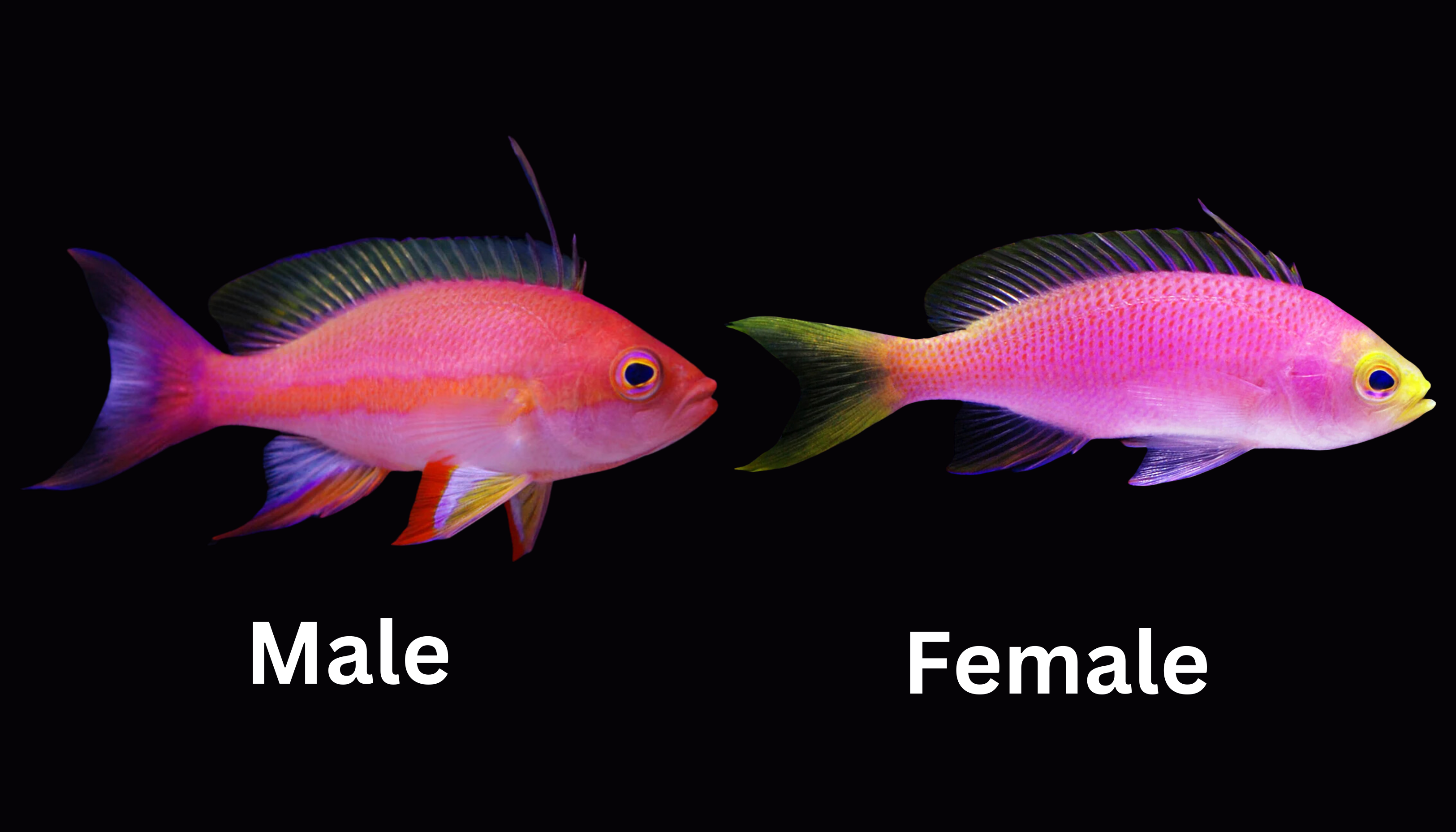
- Skill Level: Intermediate
- Care Needs:
- Tank Size: 75 gallons for small groups; add more space for larger harems.
- Diet: Microplankton feeders; thrives on enriched frozen foods like rotifers and small copepods.
- Behavior: Peaceful and sociable, making them great for community tanks.
- Concerns: May fade in color if not fed a nutritionally rich diet.
Tamara's Pro Tip: Resplendents are hardy but need regular feedings and low competition to remain healthy and vibrant.
9. Randall’s Anthias (Pseudanthias randalli)
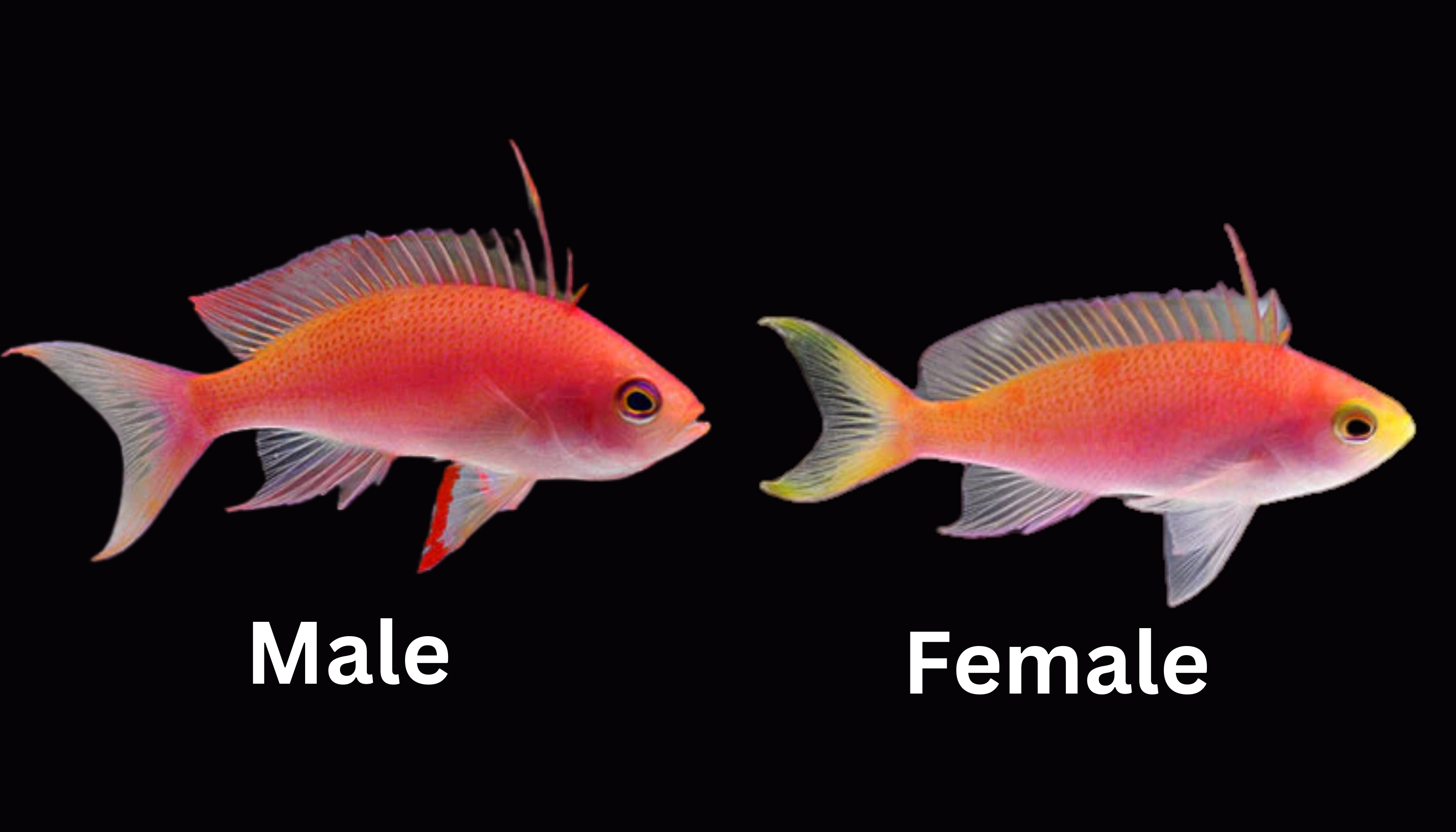
- Skill Level: Intermediate
- Care Needs:
- Tank Size: Minimum 75 gallons for small harems; 100+ gallons for larger groups.
- Diet: Thrives on frozen plankton, mysis shrimp, and enriched brine shrimp. Requires small, frequent feedings (at least 3 times daily).
- Behavior: Peaceful and prefers a harem structure (1 male to 3–5 females).
- Concerns: Sensitive to water quality fluctuations and may struggle in tanks with aggressive feeders.
Tamara's Pro Tip: Randall’s Anthias love aquascapes with plenty of caves and overhangs for shelter. Ensure ample hiding spots to reduce stress.
10. Evansi Anthias (Mirolabrichthys evansi)
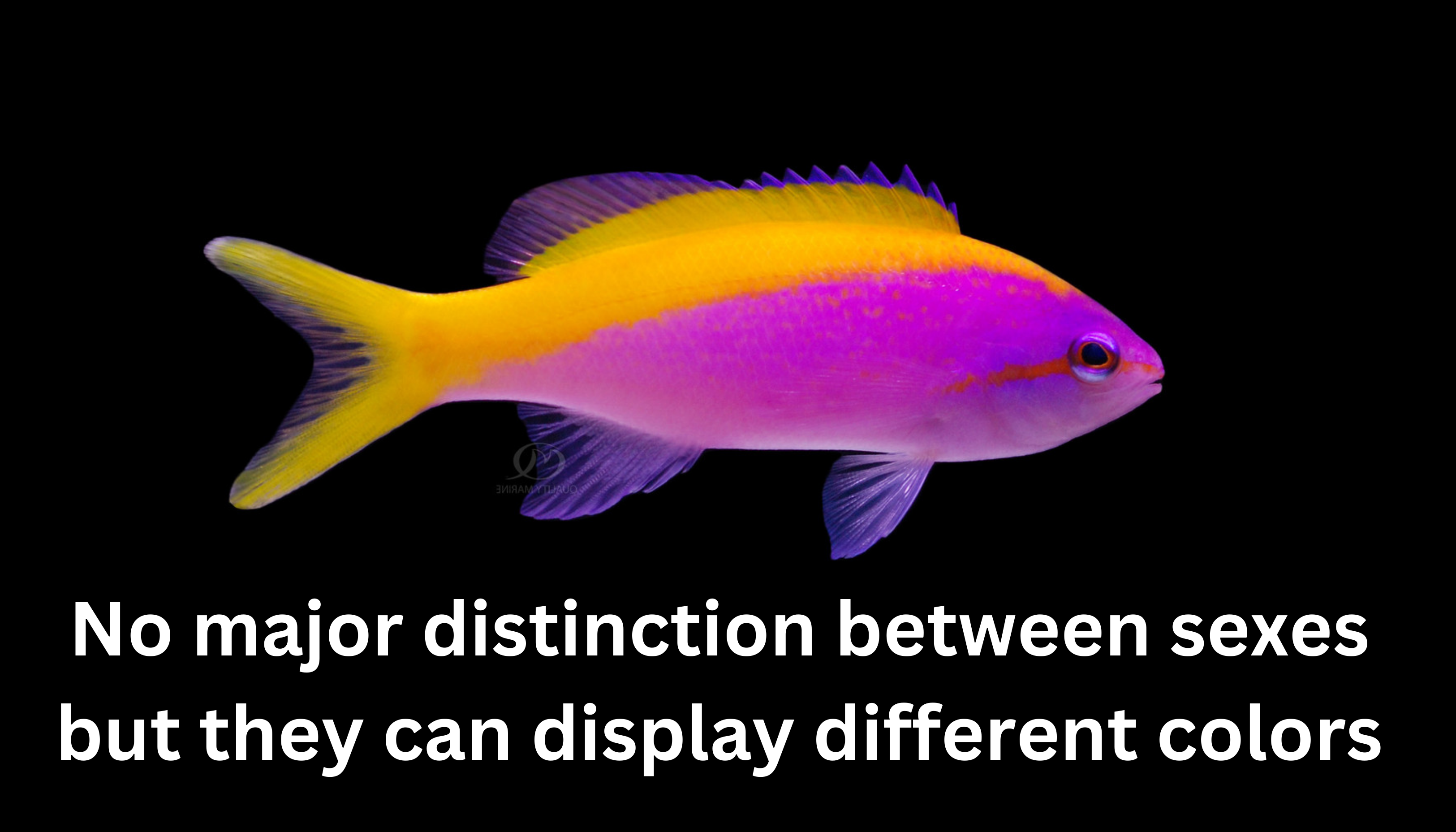
- Skill Level: Advanced
- Care Needs:
- Tank Size: Minimum 100 gallons for shoals of 6 or more individuals.
- Diet: Demands a high-frequency feeding schedule (3–4 times daily) of live or frozen plankton, enriched mysis shrimp, and rotifers.
- Behavior: Shoaling species that thrives in large groups; shy and sensitive to aggressive tank mates.
- Concerns: Prone to malnutrition and stress if not fed consistently. Requires pristine water quality and stable parameters.
Tamara's Pro Tip: Evansi anthias are visually stunning but very demanding. Consider them only if you’re ready for the commitment of high feeding and water stability.
11. Purple Queen Anthias (Mirolabrichthhys tuka)

- Skill Level: Advanced
- Care Needs:
- Tank Size: Minimum 75 gallons for small groups, though 125+ gallons is ideal for larger harems to reduce stress and ensure proper social dynamics.
- Diet: Extremely challenging to feed; thrives on live or frozen zooplankton, enriched brine shrimp, rotifers, and finely chopped seafood. Requires frequent feedings, ideally 3–4 times daily, to match its high metabolic needs.
- Behavior: Prefers low-light tanks or shaded areas, mimicking the subdued lighting of their natural deepwater habitats. Benefits from a tank with moderate-to-high flow to simulate reef currents.
- Concerns: Highly sensitive to bright lighting, aggressive tankmates, and fluctuating water parameters. Struggles in tanks that don’t provide consistent, high-quality feeding regimens or stable environmental conditions.
Tamara’s Pro Tip: Purple Queens are stunning but notoriously delicate. Their feeding challenges and need for specialized care make them best suited for dedicated, experienced aquarists with time and resources to meet their demanding needs. Provide plenty of hiding spaces and keep competition low to reduce stress levels.
12. Tiger Queen Anthias (Pryonotanthias lori)
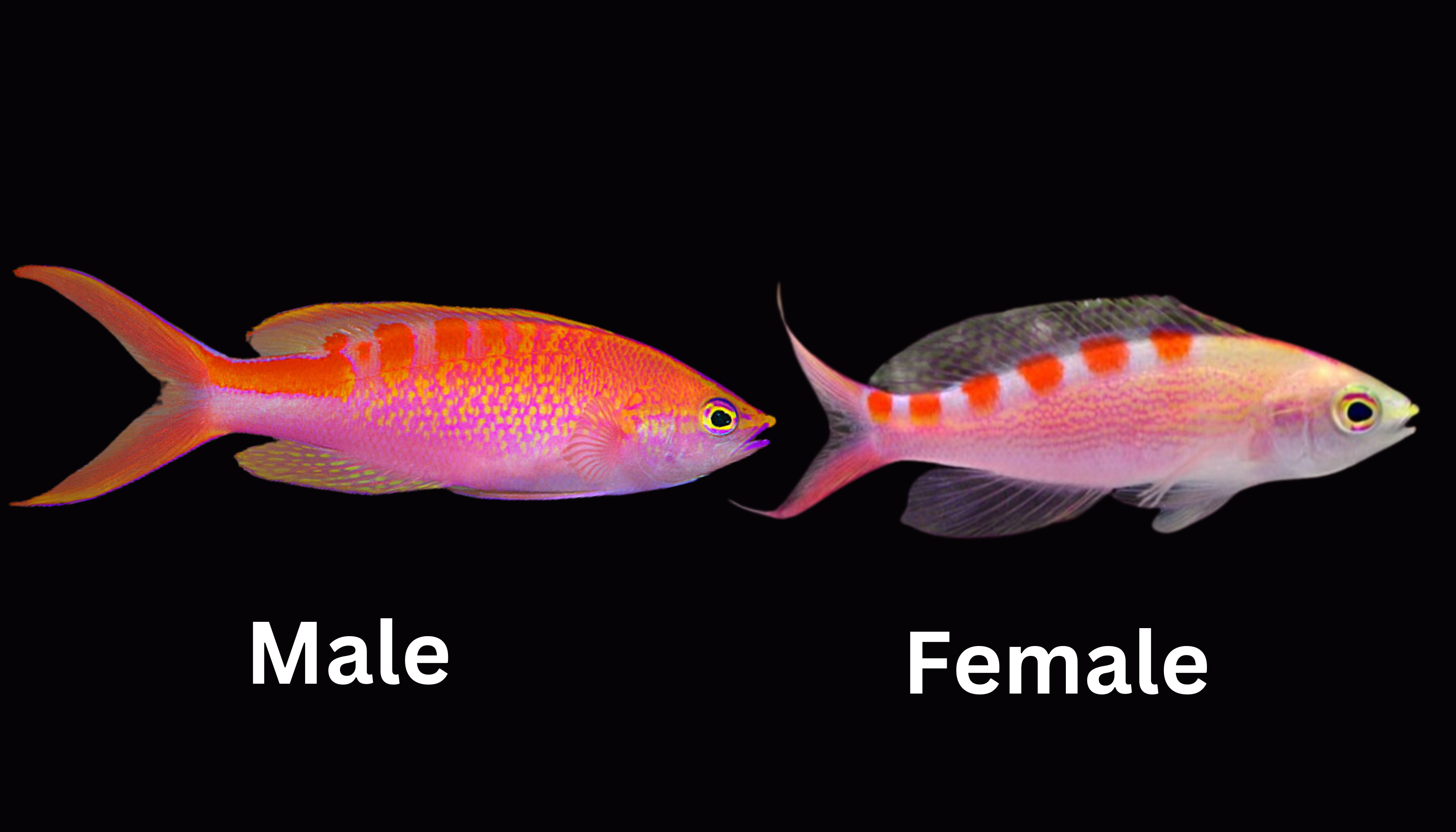
- Skill Level: Intermediate to Advanced
- Care Needs:
- Tank Size: Minimum 100 gallons for small harems; larger setups for mixed species tanks.
- Diet: Carnivorous; enjoys frozen mysis, copepods, and finely minced seafood. Small, frequent feedings are essential to maintain energy levels.
- Behavior: Highly active and stunning midwater swimmers. Requires a peaceful environment with plenty of swimming space.
- Concerns: Males can become territorial if space is limited. Watch for aggression within the group if the harem ratio is off.
Tamara's Pro Tip: Tiger Queen Anthias are show-stoppers in reef tanks. Keep them with non-aggressive tank mates and provide a balance of open swimming areas and secure hiding spots.
Chart comparing 12 anthias species and their needs
| Species | Feeding Frequency | Lighting Requirements | Max Size | Min Tank Size | Harem Size | Special Notes |
|---|---|---|---|---|---|---|
| Lyretail Anthias | 2–3x daily | Standard reef lighting | 5 inches | 75 gallons | 1 male: 4–6 females | Hardy and beginner-friendly; thrives in well-oxygenated tanks with ample flow. |
| Bartlett’s Anthias | 2–3x daily | Standard reef lighting | 4 inches | 70 gallons | 1 male: 4 females | Bold and active; may become aggressive without enough females. |
| Dispar Anthias | 2–3x daily | Standard reef lighting | 4 inches | 75 gallons | 1 male: 4–5 females | Peaceful and less aggressive; requires a varied diet to maintain vibrant colors. |
| Sunburst Anthias | 3x daily | Subdued lighting | 5 inches | 50 gallons | Solitary or 2–3 max | Shy; benefits from quieter tanks with caves and overhangs for hiding. |
| Squareback Anthias | 3x daily | Standard reef lighting | 7 inches | 125 gallons | 1 male: 4–6 females | Larger and territorial; needs ample space and careful harem management. |
| Bicolor Anthias | 3x daily | Standard reef lighting | 5 inches | 100 gallons | 1 male: 4 females | Picky eater; acclimation to frozen foods may take time. |
| Threadfin Anthias | 3x daily | Standard reef lighting | 4 inches | 75 gallons | 1 male: 5–6 females | Tightly schooling; needs strong current to replicate reef conditions. |
| Resplendent Anthias | 2–3x daily | Standard reef lighting | 3 inches | 75 gallons | 1 male: 4–5 females | Hardy and vibrant; low competition is crucial for consistent feeding. |
| Randall’s Anthias | 3x daily | Standard reef lighting | 4 inches | 75 gallons | 1 male: 3–5 females | Peaceful and colorful; thrives in stable, well-maintained reef tanks. |
| Evansi Anthias | 3–4x daily | Standard reef lighting | 4 inches | 100 gallons | 1 male: 5–6 females | Difficult to acclimate; prefers live foods and enriched frozen diets. |
| Queen Anthias | 3–4x daily | Subdued lighting | 4 inches | 75 gallons | 1 male: 4 females | Deepwater species; sensitive to bright lights and fluctuations in water quality. |
| Tiger Queen Anthias | 3x daily | Standard reef lighting | 5 inches | 100 gallons | 1 male: 5–6 females |
Bold and active; requires excellent flow and a varied diet to thrive. |
Tank Setup for Anthias: Digging Into the Details
Creating the perfect environment for anthias is key to their health, behavior, and vibrant coloration. Here’s a closer look at what they need to thrive:
1. Tank Size: Room to Roam
- Why 75 Gallons Minimum? Anthias are active swimmers with a natural preference for schooling in open water. A 75-gallon tank provides sufficient space for small groups (e.g., 3–5 individuals). However, their schooling nature and hierarchy dynamics mean they’ll benefit from even larger setups, especially when housing multiple species or larger shoals.
- Larger Tanks (100+ Gallons): With more space, anthias exhibit more natural behaviors and better stress management. Larger tanks also reduce territorial aggression, which is particularly important for species like Lyretail Anthias with dominant males.
Tamara's Pro Tip: If you’re dreaming of keeping multiple anthias species, aim for at least a 125-gallon tank. The additional volume minimizes interspecies conflict and ensures stable water parameters.
2. Aquascape: Balancing Shelter and Open Space
-
Rockwork for Hiding and Resting:
- Anthias retreat to caves or crevices to rest at night or when stressed. Incorporating varied rockwork with multiple hiding spots ensures every fish has a safe retreat.
- Vertical structures also provide midwater cover, mimicking their natural reef habitat.
-
Open Swimming Areas:
- Anthias spend most of their time in the water column rather than close to the substrate. Clear, open spaces between rock formations allow them to exhibit natural darting and schooling behaviors.
- Leave the center or top third of the tank open for uninterrupted movement.
Tamara's Pro Tip: When aquascaping, aim for a U-shaped or island layout. This provides both shelter and open space while optimizing flow for the entire tank.
3. Optimal Water Parameters
Anthias are sensitive to water quality and demand pristine conditions:
-
Temperature: 74–78°F.
- Anthias hail from tropical reefs, making stable temperatures crucial. Sudden drops or spikes can lead to stress and disease susceptibility.
-
Salinity: 1.023–1.025 SG.
- Mimic natural seawater salinity for optimal health. Invest in a reliable refractometer for precise measurements.
-
pH: 8.1–8.4.
- A stable pH supports biological processes and reduces stress. Fluctuations can impair their immune system and metabolism.
-
Alkalinity: 8–12 dKH.
- Alkalinity acts as a pH buffer. Maintaining proper levels is vital for both fish and coral health in a reef setup.
-
Nitrates and Phosphates:
- Nitrates: Keep levels under 10 ppm to prevent stress and promote vibrant coloration.
- Phosphates: Aim for <0.03 ppm. Elevated levels can lead to algae blooms and affect water clarity.
-
Ammonia and Nitrites: 0 ppm.
- Even trace amounts can be toxic. Ensure a fully cycled tank before introducing anthias.
- Aeration:
- Anthias are active fish and require high oxygen levels. Use powerheads and a quality skimmer to ensure proper gas exchange.
Tamara's Pro Tip: Anthias are especially sensitive to poor water quality. Weekly water testing and regular water changes (10–20%) are essential to maintaining their demanding environment.
Flow Considerations for Anthias
Moderate to high flow is essential for replicating the reef currents anthias naturally thrive in. These currents serve multiple purposes, including keeping oxygen levels high, aiding in food particle suspension, and stimulating natural swimming behaviors.
Why Flow Matters:
- Oxygenation: Strong flow ensures water movement across the tank's surface, promoting gas exchange and maintaining high oxygen levels. Anthias are active swimmers with high metabolic rates, so they require well-oxygenated water.
- Feeding: As midwater feeders, anthias rely on suspended food particles. Proper flow keeps food in motion, mimicking their natural environment and encouraging healthy feeding behaviors.
- Waste Removal: Strong flow helps prevent detritus buildup in the tank by keeping particles suspended until they’re captured by the filtration system.
Equipment Suggestions:
- Powerheads: Opt for programmable powerheads like the Ecotech VorTech or Maxspect Gyre for customizable flow patterns. These allow you to mimic the turbulence and variability of reef currents.
- Wave Makers: Devices that are effective for creating consistent movement in smaller tanks.
- Return Pumps: Ensure your return pump provides sufficient flow through the tank’s sump system to complement in-tank flow devices.
Flow Patterns to Aim For:
- Randomized Flow: Use wave makers or powerheads with variable modes to simulate the chaotic flow patterns of natural reefs.
- Gentle Areas: Create calmer zones within the tank by placing rock structures strategically, offering resting spots for anthias during periods of low activity.
- Eliminate Dead Spots: Ensure no areas of the tank lack flow, as dead spots can lead to waste accumulation and lower oxygen levels.
Tamara’s Pro Tip:
Place powerheads near the surface to create ripples and maximize gas exchange. If your tank has a mix of anthias species, ensure the flow is distributed evenly to accommodate varying activity levels. Always observe your fish—if they struggle to swim against the current or hide excessively, adjust the flow.
Lighting: Replicating the Reef
While most anthias thrive under standard reef lighting, some deeper-water species are indeed more sensitive to intense lighting. These species are naturally adapted to lower light conditions in their native habitats, such as the shaded reef slopes or deep water where sunlight penetration is minimal. For these anthias, overly bright lighting can cause stress or make them retreat to shaded areas of the tank.
Light-Sensitive Anthias Species:
-
Tuka (Purple) Anthias (Pseudanthias tuka)
- A deeper-water species (~200–300 feet).
- Requires lower light levels to feel comfortable.
-
Sunburst Anthias (Serranocirrhitus latus)
- Naturally inhabits caves or overhangs.
- Benefits from moderate lighting with plenty of shaded spaces.
-
Huchtii Anthias (Pseudanthias huchtii)
- Found in twilight zones of the reef, often between 80–200 feet.
- Prefers a mix of moderate light and darker hiding spots.
-
Ventralis Anthias (Pseudanthias ventralis)
- A deepwater species from 150–300 feet.
- Highly light-sensitive and does best in low-intensity lighting setups.
Recommendations for Light-Sensitive Anthias:
- Lighting Intensity: Use dimmable LEDs to adjust intensity. Aim for moderate PAR levels (50–100) in areas where these species congregate.
- Aquascape Design: Provide plenty of shaded areas with caves or overhangs using rockwork. This gives the fish a refuge from bright light when needed.
- Lighting Spectrum: These anthias benefit from a blue-dominated spectrum, as it closely resembles the light spectrum in deeper reef environments.
- Acclimation: Gradually acclimate light-sensitive anthias to new tank lighting to reduce stress.
Anthias That Adapt Well to Bright Lighting:
- Lyretail Anthias (Pseudanthias squamipinnis)
- Bartlett’s Anthias (Pseudanthias bartlettorum)
- Dispar Anthias (Pseudanthias dispar)
- Squareback Anthias (Pseudanthias pleurotaenia)
These species naturally inhabit shallower reef zones and are less likely to exhibit light sensitivity.
Tamara’s Pro Tip:
If your tank’s lighting is on the bright side but you want to keep light-sensitive anthias, use programmable LED lighting to create a dawn/dusk simulation. This gradual ramp-up and dim-down reduces stress and mimics natural light cycles, helping these anthias feel more at home.
Tank Mates: Fostering Harmony
Peaceful Reef-Safe Fish:
- Ideal tank mates include tangs, gobies, wrasses, clownfish, and blennies. These species complement anthias’ active nature without disrupting their hierarchy.
Species to Avoid:
- Aggressive fish like triggerfish, large angels, or dottybacks can intimidate anthias, causing stress or keeping them from feeding.
- Overly territorial species, such as maroon clownfish, may compete for shelter and disrupt schooling behavior.
Compatibility Within Anthias Groups:
- Anthias form natural hierarchies with one dominant male overseeing a harem of females. If the male dies, the largest female typically transitions to male.
- Avoid overcrowding to reduce aggression among males, and always introduce anthias in groups to minimize territorial disputes.
Tamara's Pro Tip: When adding new anthias to an established shoal, use an acclimation box to monitor behavior and ease their introduction. This reduces the risk of aggression from the dominant male.
The Ideal Male-to-Female Ratio
Anthias are protogynous hermaphrodites, meaning they are all born female and the dominant individual in a group transitions to male. This behavior plays a significant role in their social structure and impacts how you should stock them:
-
Ratio Guidelines:
- Aim for one male per group of 5–7 females. This ratio helps replicate their natural harem structure, reducing stress and aggression among the group.
- In smaller tanks, keep a single male with 3–4 females. In larger tanks, you can maintain multiple harems, but ensure ample space and rockwork to separate groups.
-
Why This Ratio Matters:
- Too Many Males: Males are territorial and will fight for dominance, leading to stress and potential injuries.
- Too Few Females: A lone male in a small group may exhibit excessive dominance or harassment behavior, stressing the females.
-
Introducing New Anthias:
- If adding anthias to an established group, try to introduce smaller, juvenile females. Juveniles are less likely to trigger aggression from the dominant male or other females.
Tamara’s Pro Tip: Observe the tank in the store for at least 5–10 minutes. Healthy anthias will display subtle schooling behavior, with the dominant male often hovering slightly above or near the females. If you notice frequent chasing or aggression, reconsider purchasing from that batch.
Selecting Healthy Anthias: Tips for Success
Choosing healthy anthias at the outset is essential for their long-term survival and happiness in your tank. Here’s how to make the right choice:
What to Look for in Healthy Anthias
-
Coloration:
- Vibrant, consistent colors are a sign of good health. Avoid fish with dull or faded patches, as this may indicate stress, malnutrition, or illness.
- Keep in mind that males typically have more vivid colors than females, as their bright hues help establish dominance and attract mates.
-
Activity Levels:
- Healthy anthias should be actively swimming in the water column, preferably in a loose group. Avoid fish hiding in corners, lying on the substrate, or exhibiting erratic movements.
- Look for those that interact confidently with their peers, as schooling behavior is a natural part of their temperament.
-
Clear Eyes and Fins:
- Bright, clear eyes are a key indicator of health. Cloudy or sunken eyes could signal bacterial infections or stress.
- Inspect the fins for any fraying, tears, or discoloration, which might indicate fin rot or physical injuries.
-
Breathing Patterns:
- Observe their gill movements. Healthy anthias should breathe steadily, without rapid or labored gill flaring. Excessive gill movement could be a sign of ammonia or nitrite poisoning or even internal parasites.
-
Feeding Behavior:
- Ask the store staff to feed the anthias. Fish that eagerly accept prepared foods, such as frozen mysis or brine shrimp, are much more likely to acclimate successfully to your tank.
- Avoid fish that show no interest in eating or seem overly shy during feeding times.
Red Flags to Avoid
- Skin Issues: White spots (Ich), stringy patches, or fuzzy growths can indicate parasitic or fungal infections.
- Lethargy: Anthias are naturally active swimmers. If they’re sitting still or hiding excessively, they’re likely stressed or unwell.
- Labored Breathing: Rapid gill movement could be a sign of poor water quality or disease.
- Poor Appetite: If they refuse food or spit it out, they may already be too stressed or ill to recover.
Acclimation for New Anthias
Once you’ve selected your healthy anthias, proper acclimation is crucial:
- Use a drip acclimation method to gradually adjust them to your tank’s salinity and water parameters.
- Keep the tank lights dimmed during their introduction to minimize stress.
- Consider using an acclimation box to monitor behavior and ease them into their new social structure.
Tamara’s Pro Tip: If your new anthias seem timid during the first few days, don’t worry—it’s normal! Offer small, frequent feedings of enticing foods like frozen mysis shrimp to help them settle in.
Health and Disease Management for Anthias
Anthias, while stunning and lively additions to reef tanks, are more sensitive than many other saltwater fish species. Their susceptibility to stress, parasites, and nutritional deficiencies makes proper care and preventive health management essential. Here’s an expanded guide to help you keep your anthias thriving.
Common Diseases in Anthias
Certain diseases are particularly problematic for anthias due to their active nature and midwater swimming habits:
-
Marine Ich (Cryptocaryon irritans):
- Symptoms: White spots on fins and body, flashing (scratching against rocks), and labored breathing.
- Why They’re Susceptible: Anthias’ high activity levels and tight schooling behavior can increase the spread of this highly contagious parasite.
- Treatment: Copper-based medications or hyposalinity treatment in a quarantine tank. UV sterilizers can help control free-swimming Ich stages in the main tank.
- Prevention: Quarantine all new fish for 2–4 weeks before introducing them to the display tank.
-
Velvet Disease (Amyloodinium):
- Symptoms: A dusty gold or brown sheen on the skin, rapid breathing, and lethargy.
- Why They’re Susceptible: Anthias’ delicate gills make them particularly prone to respiratory issues caused by Velvet.
- Treatment: Copper treatments in quarantine. Use caution with copper dosing as anthias are sensitive to high concentrations.
- Prevention: Keep stress levels low by maintaining pristine water quality and avoiding overcrowding.
-
Brooklynella (Clownfish Disease):
- Symptoms: Mucus-covered skin, difficulty breathing, and rapid gill movement.
- Why They’re Susceptible: While named after clownfish, Brooklynella can infect anthias, especially in overcrowded or poorly maintained tanks.
- Treatment: Formalin baths in quarantine. Avoid prolonged exposure to formalin, as it can irritate anthias’ sensitive gills.
- Prevention: Maintain excellent water quality and avoid introducing unquarantined fish.
-
Nutritional Deficiencies:
- Symptoms: Dull or pale coloration, lethargy, and susceptibility to secondary infections.
- Why They’re Susceptible: Anthias have high metabolic rates and require frequent, nutrient-rich meals to stay healthy.
- Treatment: Improve diet with a variety of enriched foods (e.g., mysis shrimp soaked in vitamin supplements like Selcon or garlic extract).
- Prevention: Feed small meals 2–3 times daily with a focus on variety and high-quality nutrition.
Are Some Anthias Species More Susceptible to Certain Diseases?
Yes, susceptibility to diseases and stress varies among anthias species due to their unique biological and behavioral traits:
-
Lyretail Anthias (Pseudanthias squamipinnis):
- Resilience: Considered hardy and a good option for beginners.
- Disease Susceptibility: Still prone to Ich and Velvet, especially if stressed or overcrowded.
-
Dispar Anthias (Pseudanthias dispar):
- Resilience: Moderate; tolerates a wider range of tank conditions but may struggle in competitive environments.
- Disease Susceptibility: Sensitive to nutritional deficiencies, leading to pale coloration and lethargy.
-
Bartlett’s Anthias (Pseudanthias bartlettorum):
- Resilience: Hardy and adaptable, but aggression within groups can lead to stress and secondary infections.
- Disease Susceptibility: Ich and nutritional deficiencies are common if their diet isn’t well-managed.
-
Squareback Anthias (Pseudanthias pleurotaenia):
- Resilience: Less hardy; requires stable water conditions and larger tanks due to their size.
- Disease Susceptibility: Highly sensitive to Velvet and stress-induced illness.
-
Sunburst Anthias (Serranocirrhitus latus):
- Resilience: Shy and delicate, often struggling to compete for food.
- Disease Susceptibility: Prone to nutritional deficiencies and secondary bacterial infections due to stress.
Tamara’s Pro Tip: If you’re new to anthias, start with hardy species like Lyretail or Bartlett’s Anthias. Avoid delicate species like Sunburst Anthias unless you have extensive experience managing their specific needs.
Medications to Avoid
Certain medications, while effective for some fish, can be harsh or harmful to anthias:
-
Copper-Based Treatments:
- Why Avoid: Anthias are sensitive to excessive copper levels, which can stress their delicate gills.
- Safe Use: If treating Ich or Velvet, use a chelated copper product (e.g., Cupramine by Seachem) and monitor levels carefully with a reliable test kit.
-
Broad-Spectrum Antibiotics:
- Why Avoid: Overuse can disrupt biological filtration, leading to ammonia spikes that stress anthias.
- Safe Use: Only use in a quarantine tank, and monitor ammonia levels closely.
-
Formalin:
- Why Avoid: While effective against parasites like Brooklynella, formalin can irritate anthias’ sensitive gills and skin.
- Safe Use: Limit exposure to short baths rather than prolonged treatments.
Troubleshooting Common Issues with Anthias
1. Anthias Hiding or Shy Behavior
Possible Causes:
- Stress from introduction to a new tank or aggressive tankmates.
- Insufficient hiding spots, leading to insecurity.
- Poor water quality or fluctuating parameters causing stress.
Solutions:
- Provide More Hiding Spots: Increase the amount of rockwork, caves, or overhangs where anthias can retreat and feel safe. Mimicking their natural reef environment helps reduce stress.
- Monitor Tankmates: Remove or separate overly aggressive species like certain wrasses or dottybacks.
- Stabilize Water Quality: Test parameters frequently and ensure optimal conditions, especially for ammonia, nitrites, and pH stability.
Tamara’s Pro Tip: If new anthias are shy, dim the tank lighting for a few days to help them acclimate. This reduces their stress and encourages exploration.
2. Refusal to Eat
Possible Causes:
- Picky feeding habits, especially in species like Purple Queens or Evansi anthias.
- High flow during feeding dispersing food too quickly.
- Stress from transportation or new environments.
Solutions:
- Live Food First: Offer live zooplankton, brine shrimp, or mysis shrimp to stimulate their natural hunting instincts.
- Turn Off Flow During Feeding: Allow food to settle and stay in one area, making it easier for shy eaters to grab a meal.
- Enhance Food Appeal: Use garlic-based food additives or enrichment like Selcon to entice eating.
Tamara’s Pro Tip: Anthias love a variety of small, protein-rich foods. Rotate frozen, live, and prepared options to keep them engaged and well-nourished.
3. Aggression in the Shoal
Possible Causes:
- Male dominance due to an unbalanced male-to-female ratio.
- Limited tank space, causing territorial disputes.
- Lack of social hierarchy or stress during introduction.
Solutions:
- Adjust Male-to-Female Ratio: Aim for at least 4–6 females per male to distribute aggression and create a harmonious shoal dynamic.
- Provide Space: Larger tanks reduce territorial disputes. If aggression persists, consider upgrading the tank or removing aggressive individuals.
- Rehome Problematic Fish: If a male becomes overly dominant or aggressive, rehoming may be necessary for the health of the group.
Tamara’s Pro Tip: Introduce all anthias at the same time to establish a stable hierarchy early on. Adding new individuals to an established group can disrupt the balance.
FAQs About Anthias
1. Can Anthias Be Kept in Nano Tanks?
No, anthias require plenty of swimming space and prefer to school. A tank size of at least 75 gallons is necessary for small groups, with larger tanks recommended for multiple species or larger harems.
2. What’s the Ideal Group Size?
A minimum of 3 anthias (one male and two females) is recommended for small tanks. In larger setups, aim for groups of 5–10 to encourage natural schooling behavior and reduce male aggression.
3. How Long Do Anthias Live?
With proper care, anthias can live between 5–7 years in captivity. Their longevity depends on stable water quality, a varied diet, and appropriate social dynamics.
4. Why Do Anthias Lose Color?
Common causes of fading coloration include:
- Poor Diet: Lack of nutrient-rich foods like mysis shrimp, copepods, and vitamin-enriched options.
- Stress: Aggressive tankmates or suboptimal tank conditions.
- Lighting Issues: Insufficient spectrum or intensity to highlight their vibrant hues.
Tamara’s Pro Tip: Ensure anthias are fed high-quality frozen or live foods enriched with color-enhancing additives like astaxanthin or spirulina.
Conclusion
Caring for anthias is a rewarding challenge, combining the beauty of the reef with the satisfaction of keeping these vibrant fish healthy and happy. While they require commitment, frequent feedings, and stable water quality, the payoff is a tank full of dazzling, active fish that bring your reef to life.
